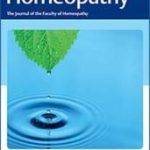S Bernardini and A Dei
Hormesis may provide a central concept for homeopathy development
Toxicol Appl Pharmacol 2006, 211: 84-85

Several toxicological studies have stressed that the interaction between a living organism and a large number of xenobiotics is characterised by a biphasic dose-response behaviour. (Calabrese, 2005a,b) Indeed a stimulatory response is observed when low doses are used, whereas an inhibitory effect is observed when the xenobiotic dose is increased. Although this was observed more than a century ago, the phenomenon was later defined as hormesis. (Southam and Ehrlich, 1943) The stimulatory response is often modest and difficult to detect so the phenomenon was not significantly considered by the scientific community. However the large amount data collected to date seems to suggest that hormesis represents a general biological phenomenon, thus deserving high consideration. In practice it represents a revolutionary breakthrough of the biological and medical thought dictating that , as stressed by Calabrese and coworkers in the recent past,(Calabrese and Baldwin, 2003) toxicology and pharmacology should rethink its central beliefs...




